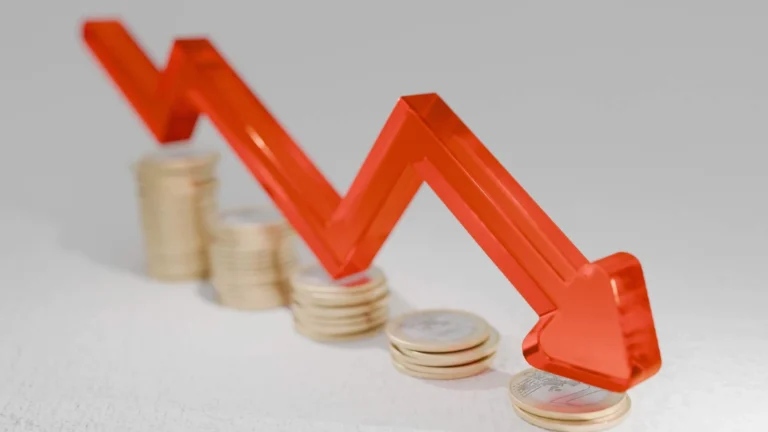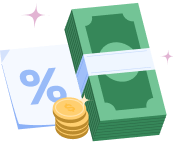Table of Contents
If you’ve noticed higher bills or your savings don’t go as far, you’ve felt inflation. You may hear, “The Fed is raising interest rates,” but few understand why.
Inflation and interest rates have a strong relationship. Both are responsible for borrowing costs, the return on savings, as well as the general health of finances. Knowing their relationship keeps you proactive rather than reactive.
Without a doubt, Everdraft and AI Wallet are great tools to assist you in monitoring your expenses and budgeting during inflation. They keep your money organized despite economic fluctuations. This blog explains the link between inflation and interest rates and illustrates how Beem can help.
Understanding Inflation: When Prices Rise Faster than Income
Inflation refers to the continuous, gradual increase in the prices of goods and services. A decrease in the purchasing power of money is the consequence of the phenomenon called inflation, and thus, the prices of everyday goods and services become higher over time.
Let’s say that your groceries and rent increase by 5% per year while your income only goes up by 2%; in this case, you have less to spend. This gap between living costs and income growth rates can slowly tighten your budget even if your salary looks bigger.
Some reasons may cause inflation, such as:
- Higher consumer demand
- Production shortages
- Excess money in circulation
Understanding Interest Rates: The Cost of Borrowing Money
Interest rates denote the amount of money you have to pay if you borrow, while at the same time, the bank will pay you a certain amount if you deposit your money with it.
For example, when banks increase lending rates, mortgage payments, credit card payments, and auto loan payments increase. Yet, they might gain a bit more on deposits, providing their cash with a little kick over time.
Central banks, like the U.S. Federal Reserve, set benchmark interest rates to balance the economy. They raise the rates when they want to control inflation and reduce them if they want to encourage consumption and growth.
How Inflation and Interest Rates Interact?
Inflation and interest rates are closely linked. Here’s how:
- When the prices of goods and services start rising, the banks will increase interest rates.
- However, if the economy is weak, the banks will drop the rates to make it more attractive for spending and investing.
In a way, using money from the risky side is like stepping on the brakes on a car that is going too fast, while energy is like putting down the accelerator. Households and companies that realize the links could better manage their money.
1. Rising Inflation Pushes Interest Rates Up
When prices increase more quickly than predicted, lenders adjust to maintain money’s value. Inflation means that money in the future will be less valuable, so interest rates rise to offset this. This adjustment carries over into common loans and credit.
Here’s how it impacts you:
- Home loans are more expensive, and mortgage rates are higher.
- The monthly payment on the debt will increase if the interest rate of the credit card is raised.
Knowing why inflation fuels rates enables families to plan and budget prudently. Beem’s AI Wallet monitors every rate-sensitive payment, such as EMIs, credit card payments, and loans in real time.
2. High Interest Rates Cool Down Inflation
The increase in interest rates causes borrowing to be more expensive, and consumers naturally limit their spending. Such a situation leads to a decrease in demand, helping ease the rise of prices and maintain economic stability.
Here is what happens when interest rates rise:
- Fewer individuals are purchasing automobiles or acquiring home mortgages, which causes less strain on automobile manufacturers and the housing market.
- Companies put off growth and major investments because borrowing becomes more expensive.
- Overall consumer demand falls, easing inflation in the short term
Understanding this effect allows households to plan purchases and avoid overextending themselves. Beem’s AI Wallet helps users monitor spending patterns and adjust budgets when high rates impact monthly expenses.
3. The Time Lag: Why Changes Don’t Happen Overnight
Interest rate changes don’t affect the economy immediately. It can take months for higher or lower rates to influence spending habits, lending behavior, and overall inflation.
Here’s how the lag shows:
- A rate hike in March may not reduce consumer prices until late summer
- Households and businesses take time to adjust their borrowing or investment decisions
- The full economic impact unfolds gradually, not instantly
Beem’s AI Wallet gives early insights on rising costs, helping users plan budgets proactively before the effects of rate changes are fully felt.
4. How Interest Rate Changes Affect Your Everyday Finances
Changes in the interest rate can have an effect on the decisions that money matters or finance make; however, families who grasp this fact can benefit greatly from it by efficiently managing their funds.
Here is how it impacts your finances:
- Loans and Credit: The cost of borrowing goes up with higher rates, while it becomes more manageable with lower rates.
- Savings and Deposits: Those who save get higher returns with higher rates, but are less motivated when rates go down.
- Investments: Rising rates benefit fixed-income options but can decrease stock prices.
Beem’s ecosystem provides a clear view of all cash flow, loan payments, and investments, empowering users to plan smarter in any rate environment.
5. The Double-Edged Sword of Inflation for Borrowers and Savers
The way inflation is structured causes it to play differently for borrowers and savers. Understanding the balance helps households protect their financial stability.
Here’s how:
- Those with debts are in a more favorable position as inflation diminishes the real value of fixed-rate loans.
- Real purchasing power is reduced when inflation exceeds deposit interest.
- А family with a fixed mоrtgаge sees their debt shrink, but their savings lose value.
Using Beem’s HYSA comparison tools, users can identify accounts that outpace inflation, protecting savings and making smarter financial decisions.
6. How Businesses React to Interest Rate Swings
The reaction of businesses to rate hikes or drops is very quick, and this, in turn, has a profound effect on people and the economy. Families that spot these changes can become more secure in the face of the upcoming changes.
Here’s how the business reacts:
- Small businesses reduce expansion or hiring when borrowing costs rise
- Higher financing costs often translate to slightly higher prices for goods and services
- Slower business growth can affect job availability and overall consumer spending
Beem helps both individuals and small business owners track expenses, manage cash flow, and respond efficiently to shifting rates.
7. Why Interest Rate Decisions Affect Every American
Interest rate moves aren’t just abstract economic news—they touch every household’s finances. Understanding this ensures better money decisions.
Here’s what to consider:
- Homebuyers experience rising mortgage costs when rates increase
- Savers see returns fluctuating depending on deposit rates
- Investors and families saving for education or retirement notice shifts in investment performance
Beem’s AI Wallet consolidates all savings, spending, and borrowing insights into a single dashboard, making rate changes easier to navigate for every American.
8. Managing Your Money in a High-Rate Environment
As interest rates go up, taking care of money in advance keeps your budget balanced and avoids sudden stress.
Here’s what to do:
- Pay down variable-rate debts first to reduce interest costs
- Move idle cash into high-yield savings accounts
- Delay large financed purchases if possible
- Keep liquidity ready through Everdraft™ instead of relying on credit cards
- Track loans and subscriptions with Beem’s AI Wallet to avoid unnoticed spikes
Following these steps ensures households stay in control and protect their finances during high-rate periods.
9. Managing Your Money When Rates Fall
When rates fall, you have to manage your money. The period of low rates is an ideal time for households to make progress, but without a plan, they might not be able to take advantage of it. One can save more and cut down on unnecessary expenses with the right strategy.
Here’s how to manage your money:
- Refinance expensive loans to lock in lower interest payments
- Reevaluate fixed-rate debts to take advantage of reduced costs
- Boost emergency savings contributions while borrowing is cheap
- Invest long-term prudently, balancing reward and risk
Beem saves users time tracking savings and adjusting expenses, allowing them to get the best out of low-rate conditions while planning for changes ahead.
The Beem Edge: Staying Ahead of Inflation and Interest Changes
Managing finances can be challenging when there is inflation and changes in interest rates. With Beem, you’re not just responding to economic changes; you’re staying ahead. Its smart tools and real-time insights turn financial uncertainty into control, giving you confidence no matter how rates or prices shift.
Here’s how Beem helps you:
- AI Wallet monitors what you spend. It flags categories sensitive to inflation, allowing you to detect rising costs before they have an effect on your budget.
- Everdraft lets you have instant access to money when the situation is unexpected, and there is no interest on the cash borrowed.
- The Beem Pass provides you with cashbacks and rewards that help cover the costs of the day; thus, it becomes simpler for you to make your money last longer.
FAQs on Link Between Inflation and Interest Rates
Why do interest rates rise when inflation increases?
Interest rates rise when inflation increases because monetary policymakers want to protect the value. Higher rates make borrowing more expensive, slow spending, and help prevent prices from rising too quickly.
How does a high interest rate affect my savings?
Individuals who save will benefit from high interest rates. However, it should be noted that if inflation rises at a faster rate than the interest rate, the real purchasing power of the savings will decrease.
Does lowering interest rates cause inflation?
Lowering the rates makes borrowing easier, and more spending is expected to be done. When demand exceeds supply, prices tend to go up, creating a potential inflationary gap, which is the reason why rate cuts need to be implemented with caution and only after adequate economic planning.
How can Beem help during interest rate hikes?
Beem has an AI wallet that tracks expenses, loans, and subscriptions. When payments spike, Everdraft provides instant, no-interest cash to help you stay on top of bills.
What’s the best strategy when both inflation and rates are high?
Focus on reducing debt and maintaining cash flow with Everdraft. You can place savings in accounts or investments that grow faster than inflation to protect your money.
Conclusion — Master the Money Cycle With Beem
Understanding how inflation and interest rates connect is important for smart decisions in the financial world. Being aware of the shifts helps you stay on top.
Beem makes it easy to manage these chаnges, with instant, no-interest cash аnd the ability to track sреnding, loans, and savings trends. It helps you plan, save, аnd spend wisely, keeping your financеs balanced even when the economу changes.
Download Beem today to be ready for economic changes and manage money smаrtеr with real-time insights, flexible liquiditу, and intelligent planning tools.
















































